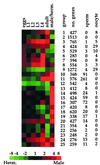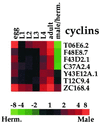Genome-wide analysis of developmental and sex-regulated gene expression profiles in Caenorhabditis elegans
- PMID: 11134517
- PMCID: PMC14571
- DOI: 10.1073/pnas.98.1.218
Genome-wide analysis of developmental and sex-regulated gene expression profiles in Caenorhabditis elegans
Abstract
We have constructed DNA microarrays containing 17,871 genes, representing about 94% of the 18,967 genes currently annotated in the Caenorhabditis elegans genome. These DNA microarrays can be used as a tool to define a nearly complete molecular profile of gene expression levels associated with different developmental stages, growth conditions, or worm strains. Here, we used these full-genome DNA microarrays to show the relative levels of gene expression for nearly every gene during development, from eggs through adulthood. These expression data can help reveal when a gene may act during development. We also compared gene expression in males to that of hermaphrodites and found a total of 2,171 sex-regulated genes (P < 0.05). The sex-regulated genes provide a global view of the differences between the sexes at a molecular level and identify many genes likely to be involved in sex-specific differentiation and behavior.
Figures




References
Publication types
MeSH terms
Substances
LinkOut - more resources
Full Text Sources
Other Literature Sources
Molecular Biology Databases

